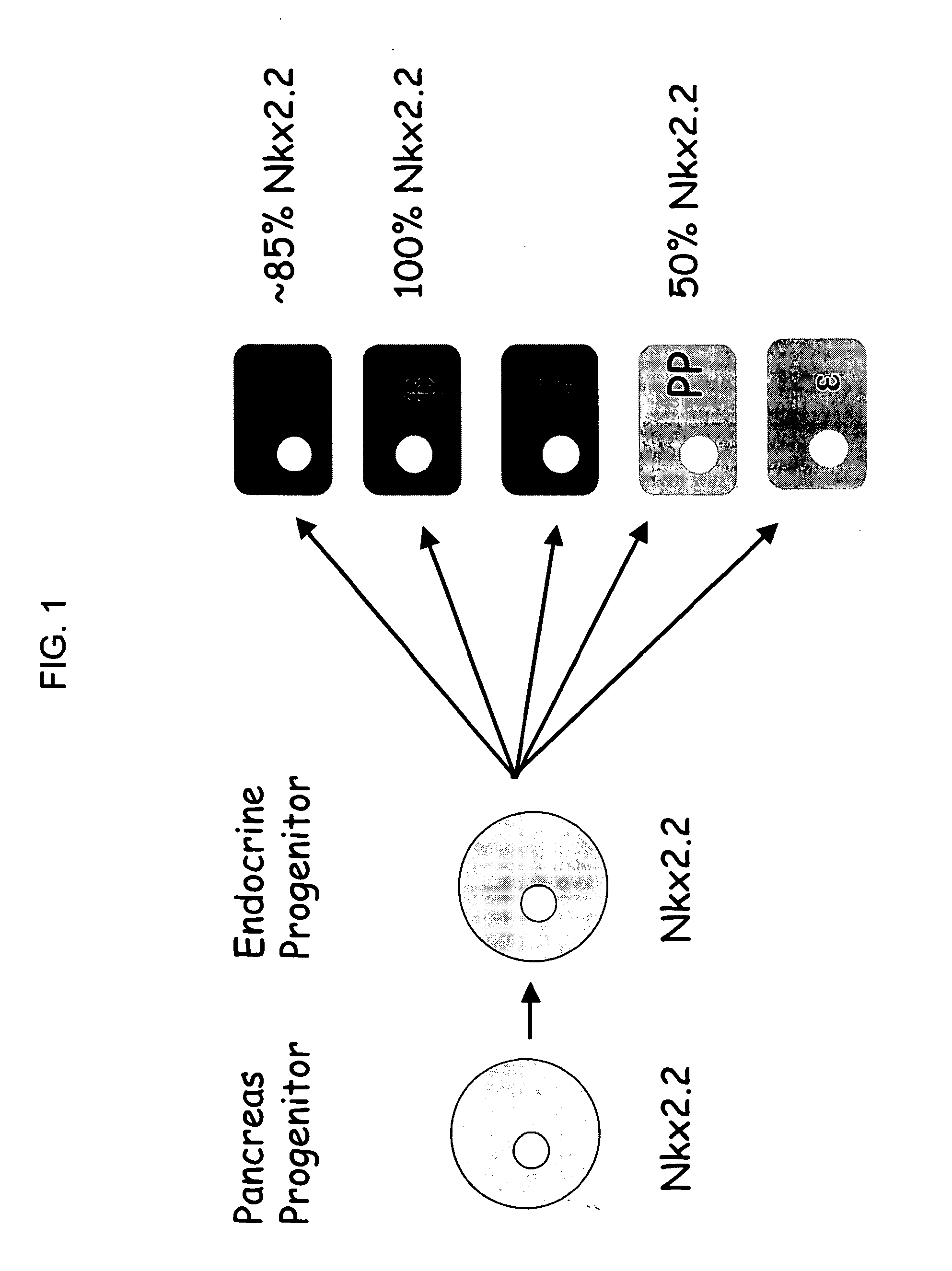Tm4sf4 and modulators thereof and methods for their use
a technology of tm4sf4 and cell population, which is applied in the direction of antibody medical ingredients, peptide/protein ingredients, metabolic disorders, etc., can solve the problems of non-functional cell formation and poorly understood regulatory pathways of these factors to direct islet cell differentiation, and achieve the effect of increasing the production of -cells
- Summary
- Abstract
- Description
- Claims
- Application Information
AI Technical Summary
Benefits of technology
Problems solved by technology
Method used
Image
Examples
example 1
Immunofluorescence of Pancreas from Nkx2.2 Null Mice
[0089]Nkx2.2+ / − heterozygous mice were generated by homologous recombination (1). Briefly, to generate a Nkx2.2 knockout construct, three overlapping genomic clones were isolated from a phage library of mouse genomic sequences. The neomycin resistance gene was cloned into the genomic locus in place of the two Nkx2.2 coding exons. The knockout construct was introduced into ES cells by electroporation, selecting for Neo resistance. Cells containing the correct recombinant were identified by southern analysis. The Nkx2.2 KO ES cells were introduced into mice using standard technologies.
[0090]Nkx2.2+ / − heterozygous mice were maintained on a Swiss Black (Taconic) background. Genotyping of mice was performed by PCR analysis as described (1,9). P0 mice were harvested, fixed overnight in 4% paraformaldehyde, and cryoprotected in sucrose and OCT embedding material. Immunofluorescence was performed on frozen 10 μm sections. Antibodies used w...
example 2
[0091]Embryonic pancreas tissue (e 12.5 and e 13.5) was collected from either wild-type or Nkx2.2 knockout embryos. Tissue was dissected and stored in RNALater (Ambion, Houston, Tex.) until the genotypes were established. mRNA was extracted from the embryonic pancreas tissue using the RNeasy kit (Qiagen, Valencia, Calif.). The RNA was then shipped to the Penn Genomics Core (University of Pennsylvania, Philadelphia, Pa.) and processed for either the PancChip or the Agilent mouse chip.
example 3
PancChip Analysis
[0092]The concentration of the nucleic acid samples was determined using the Nanoprop® ND-1000 UV-Vis Spectrophotometer. RNA samples were analyzed using an Agilent 2100 Bioanalyzer Lab-On-A-Chip Agilent 6000 Series II chip to determine the integrity of the samples.
Experimental Design
[0093]In the current study, with one test and one control condition of interest, a direct comparison design was used. Each sample was labeled and hybridized as either Test (Cy5) vs. Control (Cy3) (M) or Control (Cy5) vs. Test (Cy3) (-M). After analysis, the M values were swapped so that Fold Changes were expressed as Test / Cont for each hybridization. The set up is shown in Table 1 below.
TABLE 1Cy-5Cy-3HybridizationBarcode(Red)(Green)Die Swapcomment113687835WT4KO4−M213687836WT5KO5−M313687870WT1KO1−M413687871KO2WT2 MHybRejected513687872KO3WT3 M
Labeling and Hybridization
[0094]Approximately 200 ng of total RNA was amplified using the MessageAmp™ II aRNA Amplification Kit (Ambion, Houston, ...
PUM
 Login to View More
Login to View More Abstract
Description
Claims
Application Information
 Login to View More
Login to View More - R&D
- Intellectual Property
- Life Sciences
- Materials
- Tech Scout
- Unparalleled Data Quality
- Higher Quality Content
- 60% Fewer Hallucinations
Browse by: Latest US Patents, China's latest patents, Technical Efficacy Thesaurus, Application Domain, Technology Topic, Popular Technical Reports.
© 2025 PatSnap. All rights reserved.Legal|Privacy policy|Modern Slavery Act Transparency Statement|Sitemap|About US| Contact US: help@patsnap.com



